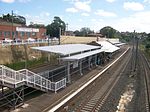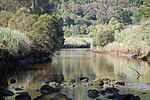Dappeto

Dappeto is a heritage-listed residence at 171 Wollongong Road, Arncliffe, New South Wales, Australia. It was built in 1885 by Frederick Gibbins. It is also known as Macquarie Lodge and Dapetto. The property is owned by the Salvation Army. It was added to the New South Wales State Heritage Register on 2 April 1999.
Excerpt from the Wikipedia article Dappeto (License: CC BY-SA 3.0, Authors, Images).Dappeto
Fairview Street, Sydney Arncliffe
Geographical coordinates (GPS) Address Website Nearby Places Show on map
Geographical coordinates (GPS)
| Latitude | Longitude |
|---|---|
| N -33.9396 ° | E 151.1349 ° |
Address
Macquarie Lodge Aged Care Centre
Fairview Street
2205 Sydney, Arncliffe
New South Wales, Australia
Open on Google Maps
Website
agedcare.salvos.org.au
Nearby Places

Lydham Hall
Lydham Hall is a State heritage-listed former rural residence at 18 Lydham Avenue, Rockdale in New South Wales, Australia. The parcel the land purchased by Joseph Davis in 1860, was part of the original 1200 acres Grant to James Chandler, and was initially named Lidham Hill. It is currently known as Lydham Hall. The building was erected in between 1878-1878.[1] It stands on the highest point of land between the Cooks River and the Georges Rivers. The Street previously known as Joseph Street was named Lydham Avenue in 1917 at the request of one of the neighbouring property owners. In 1970, Lydham Hall was purchased by the Rockdale Municipal Council. Since the 2016 Council amalgamation, the property is owned by the Bayside Council, NSW.Bayside Council. Initially, the Permanent Conservation Order No 477 in pursuance of section 44 of the Heritage Act 1977, was applied to the property on 20 August 1986. Since the implementation of the New South Wales State Heritage Register in 1999, Lydham Hall has been included into the Heritage Register. Please note that tis article is based on original documents only. The Heritage NSW articles are currently under revision by the hosting department. Please note that this article is based on the latest historical studies based on original documents.[2] The building is currently used as a local public museum holding a collection of furniture and objects dated from 1860s and run by the St George Historical Society Inc.









